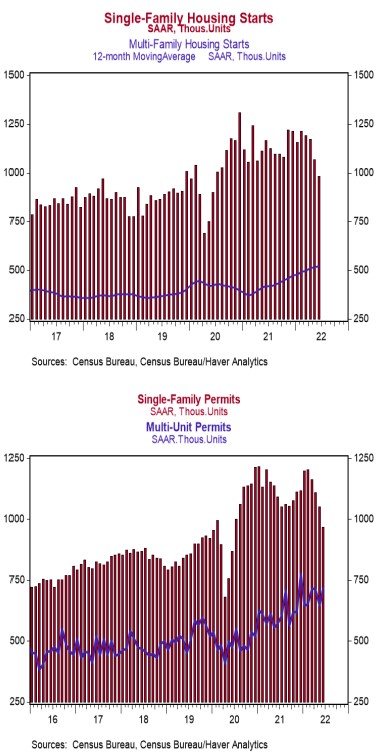- Housing starts declined 2.0% in June to a 1.559 million annual rate, below the consensus expected 1.580 million. Starts are down 6.3% versus a year ago.
- The drop in June was entirely due to single-family starts. Multi-unit starts rose in June. In the past year, single-family starts are down 15.7% while multi-unit starts are up 15.6%.
- Starts in June fell in the Midwest and South but rose in the Northeast and West.
- New building permits fell 0.6% in June to a 1.685 million annual rate, beating the consensus expected 1.650 million. Compared to a year ago, permits for single-family homes are down 11.4% while permits for multi-unit homes are up 26.0%.
Implications:
Housing starts fell for a second consecutive month in June as builders continued to navigate a challenging housing market with the highest mortgage rates since 2008, labor shortages, and ongoing supply-chain issues. That said, today’s 2.0% headline decline was the result of May’s reading on construction being revised up. Without that upward revision, June housing starts would have posted a modest gain of 0.6%. Looking at the details, single-family construction fell 8.1% in June, driving the drop in overall starts versus the revised May level. Meanwhile, multi-unit starts rose 10.3%. It is clear developers are becoming more cautious about future demand for new single-family projects with 30-year mortgage rates hovering just below 6% and are continuing to focus resources on apartment buildings. However, it also makes sense to slow down the pace of starts given how many projects are currently sitting in the pipeline. The number of homes already under construction is at the highest level on record back to 1970. Moreover, the gap between the number of units under construction and the number of completions remains at record high levels back to 1970s, as well. These figures illustrate a slower construction process due to a lack of workers and other supply-chain difficulties. In this context, it’s not surprising to see new building permits fall 0.6% in June. The backlog of projects that have been authorized but not yet started is currently sitting just below the record high since the series began back in 1999. With plenty of future building activity waiting to get underway as other projects are finished, and given that residential investment is counted in GDP when units are completed, new housing construction can continue to be a small tailwind for economic growth even with a slowdown in the headline pace of housing starts. How long this lasts is open to question, however, as homebuilder sentiment, as measured by the NAHB Housing Index, is clearly deteriorating. The index posted the largest monthly decline since the early days of the pandemic in July, falling to 55 from a reading of 67 in June. Builders’ prime concern continues to be higher mortgage rates, which are having a negative impact on potential sales as certain buyers are at least temporarily priced out of the market.





